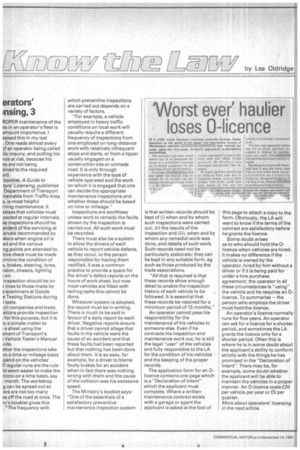erators' nsing, 3
Page 64

If you've noticed an error in this article please click here to report it so we can fix it.
ROPER maintenance of the es in an operator's fleet is amount importance. I asised this in my last . One reads almost every )f an operator being called ilic inquiry, and putting his rice at risk, because his es are not being ained to the required 3rd.
booklet, A Guide to tors' Licensing, published Department of Transport Mainable from Traffic Area s, is most helpful rning maintenance. It asises that vehicles must pected at regular intervals. se inspections should be mdent of the servicing at ervals recommended by akers when engine oil is ecl and the various ng points are attended to. tive check must be made 3rmine the condition of s, brakes, steering, tyres, nsion, chassis, lighting r on.
inspection should be on r lines to those made by a examiners at Goods e Testing Stations during I tests.
oil companies and trade ations provide inspection ; for this purpose, but it is ty a simple matter to ; a sheet using the tment of Transport's ; Vehicle Tester's Manual Jide.
ither the inspections take an a time or mileage basis ;pend on the vehicles' If regular runs are the rule Id seem easier to make the :tions on a time basis, say lmonth. The workshop g can be spread out so ere are not too many as off the road at once. The ry's booklet gives this . "The frequency with which preventive inspections • are carried out depends on a variety of factors.
"For example, a vehicle employed in heavy traffic conditions on local work will usually require a different frequency of inspections from one employed on long-distance work with relatively infrequent stops and starts, or from a tipper usually engaged on a construction site or unmade road. It is only through experience with the type of vehicle operated and the work on which it is engaged that one can decide the appropriate maintenance inspections and whether these should be based on time or mileage."
Inspections are worthless unless work to remedy the faults shown by the inspection is carried out. All such work must be recorded.
There must also be a system to allow the drivers of each vehicle to report vehicle defects, as they occur, to the person responsible for having them rectified. It was a common practice to provide a space for the driver's defect reports on the hours of work sheet, but now most vehicles are fitted with tachographs this cannot be done.
Whatever system is adopted, the record must be in writing. There is much to be said in favour of a daily report by each driver. Negative reports ensure that a driver cannot allege that faults in his vehicle were the cause of an accident and that these faults had been reported but that nothing has been done about them. It is so easy, for example, for a driver to blame faulty brakes for an accident when in fact there was nothing wrong with them and the cause of the collision was his excessive speed.
The Ministry's booklet says: 'One of the essentials of a satisfactory preventive maintenance inspection system is that written records should be kept of (i) when and by whom such inspections were carried out; (ii) the results of the inspection and (iii), when and by whom any remedial work was done, and details of such work. Such records need not be particularly elaborate; they can be kept in any suitable form, eg such as those produced by the trade associations.
"All that is required is that these records show enough detail to enable the inspection history of each vehicle to be followed. It is essential that these records be retained for a minimum period of 15 months."
An operator cannot.pass his responsibility for the maintenance of his vehicles to someone else. Even if he contracts his inspection and maintenance work out, he is still the legal "user" of the vehicles and fully responsible to the LA for the condition of his vehicles and the keeping of the proper records.
The application form for an 0licence contains one page which is a "Declaration of Intent" which the applicant must complete. Where a written maintenance contract exists with a garage or agent the applicant is asked at the foot of this page to attach a copy to the form. Obviously, the LA will want to know if the terms of the contract are satisfactory before he grants the licence.
Some doubt arises as to who should hold the 0I icence when vehicles are hired. It makes no difference if the vehicle is owned by the operator, hired by him without a driver or if it is being paid for under a hire purchase agreement; the operator in all these circumstances is "using" the vehicle and he requires an 0licence. To summarise — the person who employs the driver must hold the licence.
An operator's licence normally runs for five years. An operator can ask for a licence for a shorter period, and sometimes the LA grants the licence only for a shorter period. Often this is where he is in some doubt about the applicant's ability to conform strictly with the things he has promised in the "Declaration of Intent". There may be, for example, some doubt whether the applicant will be able to maintain the vehicles in a proper manner. An 0-licence costs £20 per vehicle per year or £5 per quarter.
More about operators' licensing in the next article.






















































































